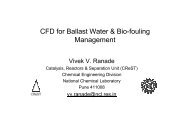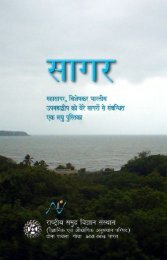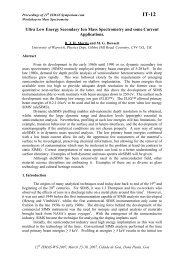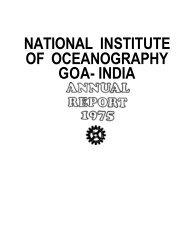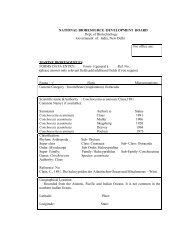1980 - National Institute of Oceanography
1980 - National Institute of Oceanography
1980 - National Institute of Oceanography
Create successful ePaper yourself
Turn your PDF publications into a flip-book with our unique Google optimized e-Paper software.
esults support the earlier findings that peninsular India had a semiarid climate in<br />
the past. Further studies on this subject are in progress.<br />
The X-ray analysis <strong>of</strong> the carbonate sediments shows that its organic constituents<br />
determine its overall mineralogy. Thus, where the benthic foraminifera are<br />
abundant, high-magnesium calcite is the prominent mineral and where molluscs or<br />
corals are found in larger proportions than others, aragonite is the prominent mineral.<br />
These studies are relevant to the problem <strong>of</strong> diagenetic changes taking place in<br />
the hydrocarbon-bearing limestones. Such diagenetic changes determine the porosity<br />
and permeability <strong>of</strong> carbonate reservoir rocks and in turn indicate the recovery <strong>of</strong><br />
hydrocarbons.<br />
3. Calcareous nannoplankton<br />
Sediment samples collected from the north western continental shelf <strong>of</strong> India<br />
during the Oceanovex programme (INS Darshak) 1973-74 were analysed. Of the<br />
total 16 species encountered, Gephyrocapsa oceanica was the most predominant<br />
whereas Emiliania huxley which is supposed to be the most abundant species in the<br />
modern seas was poorly distributed. This implies that the nannoplankton at present<br />
are subjected to predation by some other group <strong>of</strong> animals, possibly zooplantkton.<br />
The presence <strong>of</strong> G. oceanica in abundance is attributed to the relict sediment as<br />
pleistocene was its acme zone. Studies are also in progress on the variation and<br />
correlation <strong>of</strong> nannoplankton from five cores collected from the outer continental<br />
shelf <strong>of</strong>f Kerala.<br />
3.3.5 Foraminifera as indicators <strong>of</strong> pollution in the marine environment<br />
1. Foraminiferal distribution<br />
Studies <strong>of</strong> the distribution and ecology <strong>of</strong> foraminifera from Ratnagiri to<br />
Mangalore are in an advanced stage and 78 species have already been identified.<br />
The cluster analysis <strong>of</strong> foraminiferal population from Ratnagiri have led to the demarcation<br />
<strong>of</strong> two biotops.<br />
Samples from Direction Bank are being processed for the identification and<br />
estimation <strong>of</strong> organic carbon in the sediment.<br />
Virgulinella sp. which was common in Miocene and Pliocene sediments <strong>of</strong> the<br />
world was living in the present day sediments also 133 samples from the western<br />
shelf and slope and from a part <strong>of</strong> the eastern shelf were studied for the distribution and<br />
ecology <strong>of</strong> this species and its comparison with others. This species is dominant<br />
in 10-60 m depth and its maximum occurrence is in the area between Vengurla to<br />
Mangalore. Organic carbon and substrate appears to be the chief controlling factor<br />
in its distribution.<br />
Planktonic (14) and benthonic (42) foraminiferal species encountered from<br />
Deep Lake Terraces, Vestfold Hills <strong>of</strong> Antarctica revealed disparity in the abundance<br />
and dissolution effects was quite marked in certain genera.<br />
43



